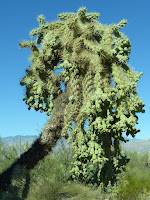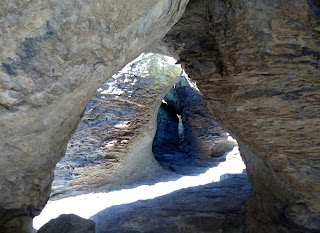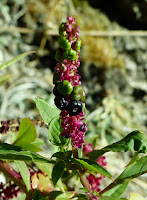There are two districts for Saguaro National Park, one on
each side of Tucson. We’d visited
Saguaro National Park West—Tucson Mountain District in February of 2011. We’d actually stopped at Saguaro National Park East—Rincon
Mountain District that year too, but it was on the way back from somewhere else, it
was late in the day, and all we did was go into the Visitor Center for a
passport stamp. I wouldn’t let George
actually count it as a park visit.
We stopped at the Visitor Center again, this time to view
the movie and wander through the museum before we headed to the only road in
the park, the one-way Cactus Forest Loop Road through this portion of the
Sonoran Desert. We shared the road with bikes and cars, but the other critters weren't around to share.
This is a park dedicated to Saguaro cacti, the iconic
cactus of the southwestern desert. It
decorates the desert and an enormous amount of souvenirs. The holes all over this one are probably
nests pecked out by cactus wrens. It's sort of a wren condo.
As expected we saw saguaro, although nowhere as many as I
expected to see. This picture was taken
at the Cactus Forest Overlook. Looks
like it had been clearcut and was just now growing back.
Apparently in the 1930s when the park was established,
this was the most spectacular cactus forest in Arizona. But in 1937 a cold front brought record lows
to Tucson, and the saguaros started to die.
After another freeze in 1962, they realized that temperatures below
freezing for just 20 hours could kill these warm-weather giants. Now young saguaro are starting to sprout, so maybe in another 50 years, it might look like a forest again.
There are other cacti in the park too. It’s easy to see how the fish-hook barrel cactus got its
name.
For some reason I always have trouble remembering prickly
pear’s name. I think of beavertail
first, then realize that’s wrong, and have to work my way around to fruit
instead of animals. It can really spread
a lot. The red things aren’t blossoms,
but the remnants of last year’s blooms, from which new pods will grow next
spring.
Even dead and desiccated, they make a unique picture.
There are three kinds of cholla here, all wicked. The Chain Fruit Cholla can grow to tree size. They’re interesting but you don’t want to get
too close.
Staghorn Cholla are purple, and skinnier than most of the
others.
My favorite is the Teddy Bear Cholla, the one sometimes
called Jumping Cholla. Either we didn’t
see any or I missed taking pictures of them. (This picture is from another park.) Just in case you’re interested though, it comes by its Teddy Bear name
honestly--isn't it cute? But it got the Jumping name dishonestly (because it doesn't really jump).
Many years ago, there were many more saguaro. Still standing, dead saguaro look like a completely different plant. These woody ribs are what allow the large fleshy cactus to stay upright.
I’ve been to yoga classes around here where the instructor
has told us to stand like a cactus--arms out, bent up at the
elbow. That might not be as easily
recognized in other states, but everyone in
Arizona knew just what to do. (By the
way, that dead-looking bunch of sticks next to George is an ocotillo, another
desert plant. It only grows leaves when
there’s enough water, it has bright red flowers at the tips, and is covered with
vicious thorns. I love it!)
Sometimes even saguaro themselves get a little
confused in where their arms should be held.
The Riparian Overlook is on the northeast part of the
loop. There are nice views of the mountains and
more saguaro than at other overlooks. Still not a lot to get excited about—unless
you’re a cactus botanist, maybe.
At Javelina Rocks Overlook I climbed up on the rocks
while George tried to get a picture of a bird that was bouncing around beneath the
creosote bushes and mesquite.
I’d have to say that if you’re only have time to go to
one district of Saguaro National Park, you’ll see more if you go West.
More pictures of Rincon Mountain District here: Saguaro Natl Park East
Pictures of Red Hills District here: Saguaro Natl Park West
Pictures of Red Hills District here: Saguaro Natl Park West










































































